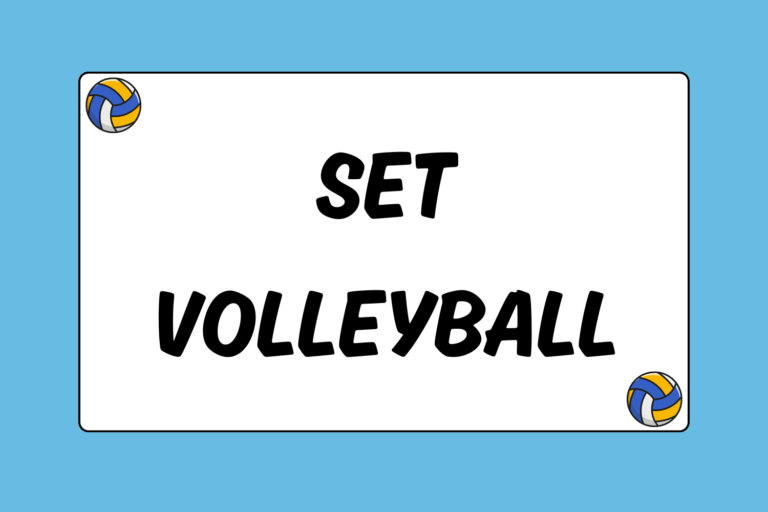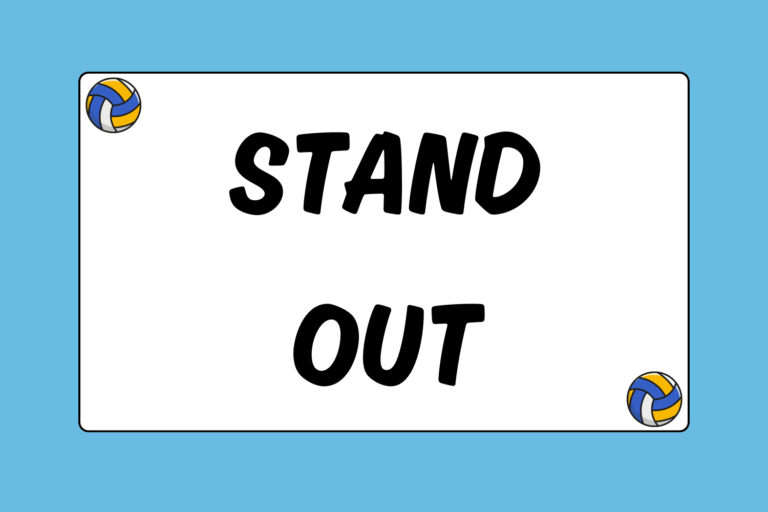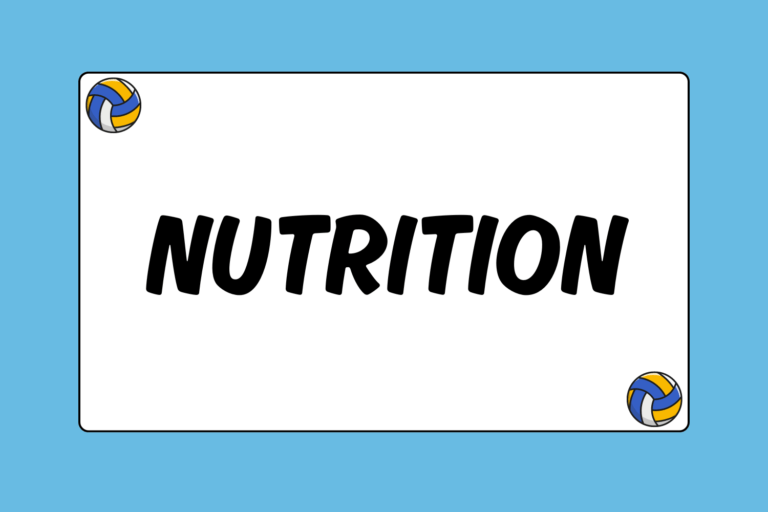#
4-2 Offense – An offensive formation where a team designates two setters, each of whom set from the right front position.
5-1 Offense – An offensive formation where a team has one designated setter and five offensive attackers.
6-2 Offense – An offensive formation with two designated back row setters.
Volleyball Glossary
A
Antenna – Vertical rods (normally white and red) mounted near the edges of the net. The antennas are considered part of the sidelines and are not-in-play.
Approach – Fast run toward the net by a spiker before he jumps in the air to hit the ball.
Assist – Awarded when a player passes, sets, or digs the ball to a teammate who attacks the ball for a kill.
Attack – An attempt to terminate the play by hitting the ball to the floor on the opponent’s side.
Attack Error – An unsuccessful attack where the hitter’s attempted attack results in a point or sideout for the opposing team; common examples include hitting the ball out of bounds or into the net.
Attack Line – The line parallel to the center line and three meters/10 feet back from the net. Sometimes called “three meter line” or “10-foot line.”
Attacker – A player who attempts to hit a ball offensively with the purpose of terminating play in his or her team’s favor. See also “hitter” and “spiker.”
B
Back Row Attack – When a back row player jumps from behind the 10-foot line before hitting the ball. If the back row player steps on or past the 3m line during take-off, the attack is illegal.
Back Set – A set delivered behind the setter’s back, which is subsequently hit by an attacker.
Ball Handling Error – Any time the official calls a double hit, a thrown ball, or a lift (except on a serve reception or attack).
Block – Awarded when a player stops the opponent’s attack by deflecting the ball back into the opponent’s court to end a rally.
Bump – A common term for forearm passing.
C
Centerline – The boundary that runs directly under the net and divides the court into two equal sides.
Closing the Block – When an assisting blocker(s) joins the primary blocker to create an impenetrable block in which the ball cannot fit between the two players. It is the responsibility of the assisting blocker to “close the block.”
Cross Court Shot – An individual attack directed at an angle from one end of the offensive team’s side of the net to the opposite sideline of the defensive team’s court.
Cut Shot – A spike from the hitter’s strong side that travels at a sharp angle across the net.
D
Dig – Slang for the act of passing a forcefully hit ball; usually the player has to get close to the floor to pass it well.
Dink – A legal push of the ball around or over blockers; players generally contact the ball with finger tips to execute a dink.
Dive – When a defensive player runs and leaps arms first to pass a ball that is hit very low to the ground.
Double Block – Two players working in unison to deflect an attacked ball at the net, back to the hitter’s side.
Double Hit – Successive hits or ball contact made by the same player. A double hit is a rule violation and considered illegal unless the double hit violation occurs during a team’s initial hit.
Double Quick – Two hitters approaching the setter for a quick inside hit.
Down Ball – An overhand hit driven over the net with topspin while the player remains standing on the ground.
E
Endline – The boundary line that marks the back of the volleyball court.
F
Facial – Slang term for a hard-driven ball that hits an opposing player in the face.
Floater Serve – A serve that does not spin or rotate and therefore moves in an erratic path. This is similar to a “knuckle ball” pitch in baseball.
Forearm Pass – A pass made by joining the arms from the elbows to the wrists, then connecting with the ball with the fleshy part of your forearms in an underhand motion.
Free Ball – A ball returned to the other side by a pass rather than a spike. This is usually called aloud by the defense instructing players to move into serve receive positions.
H
Held Ball – A ball that comes to rest during contact, resulting in a foul.
Hit – To jump and strike the ball with a forceful over-handed shot.
Hitter – See attacker.
Hitting Percentage – A statistic designed to gauge how efficiently an attacker can end a rally (get kills). Hitting percentage is determined by subtracting an attackers hitting errors from their total kills and dividing that number by total attempts.
J
Joust – When two opposing players simultaneously attempt to play a ball above the net.
Jump Serve – A serve started when the server tosses the ball into the air, then jumps and hits the ball during its downward motion.
K
Kill – An attack that terminates a rally and results in an immediate point or sideout.
L
Let Serve – A serve that contacts the net and continues over to the opposing side; now a legal play.
Lift – When the ball is held and raised up rather than hit. Also called a “carry.”
Line Shot – A ball spiked down the opponent’s sideline that is closest to the hitter and outside the block.
M
Mintonette – The original name of the game of volleyball created by William Morgan.
O
Offside Block – A player at the net on the side away from the opponent’s attack.
Off-Speed Hit – Any ball spiked with spin, but less than maximum force.
Outside Hitter – A left-front or right-front attacker normally taking an approach that starts from outside the court.
Overhand Pass – A pass executed from just above the forehead with both hands open and controlled by the fingers and thumbs.
Overhand Serve – A serve where the server strikes the ball with the hand above the shoulder.
Overlap – Refers to the positions of the players in the rotation prior to the contact of the ball when serving.
P
Pancake – A one-handed defensive technique; the hand extends while the palm slides along the floor as the player dives or extension rolls; timed so that the ball bounces off the back of the hand.
Penetration – Reaching across and breaking the plane of the net during blocking.
Point of Service – A serve that results in a point (an ace by NCAA standards) since the ball is not returned due to a bad pass by the receiver; this number includes aces.
Power Tip – A ball that is pushed or directed with force by an attacking team.
Power Volleyball – A competitive style of volleyball started by the Japanese.
Q
Quick – A player approaching the setter for a rushed inside hit.
Quick Set – A set (usually two feet above the net) in which the hitter is approaching the setter, and may even be in the air, before the setter delivers the ball. This type of set requires precise timing between the setter and hitter.
R
Ready Position – The flexed, yet comfortable, posture a player assumes before moving to contact the ball.
Reception Error – A serve that a player should have been able to return, but does not; results in an ace (and only in the case of an ace); if it is a “husband/wife” play (where the ball splits the two receivers), the receiving team is given the reception error instead of an individual.
Red Card – A severe penalty in which an official displays a red card. The result of a red card may be player disqualification, the loss of a serve, or loss of a point for the penalized team. A red card may be given with or without a prior yellow card as a warning.
Roll – A certain way to pass a ball in which the digger, or passer, lays out an arm and spins over the shoulder (an over the shoulder roll) or back (a barrel roll) after passing the ball. This is a quick way to return to action after the play.
Roll Shot – When an attacker does not swing all the way through the ball, but still snaps causing the ball to roll forward over the net and drop quickly.
Roof – When a spiked ball is blocked by a defensive player so that the ball deflects straight to the floor on the attacker’s side.
Rotation – The clockwise movement of players around the court and through the serving position following a side out.
S
Serve – One of the six basic skills and used to put the ball into play at the beginning of each point. It is the only skill controlled exclusively by one player.
Server – The player who puts the ball into play at the beginning of each point.
Service Error – An unsuccessful serve in which one or more of the following occurs: 1) the ball hits the net or fails to clear the net, 2) the ball lands out of bounds, or 3) the server commits a foot fault.
Set – The technical skill in which a ball is directed to a point where a player can spike it into the opponent’s court.
Setter – The player who has the second of the three contacts with the ball on their side of the court and sets the ball with an overhand pass for a teammate to hit. The setter normally runs the offense.
Sideline – The boundary line(s) that mark the side(s) of a regulation volleyball court.
Sideout – Occurs when the receiving team successfully puts the ball away against the serving team; or when the serving team commits an unforced error and the receiving team thus gains the right to serve.
Six-pack – See facial.
Spike – A ball contacted with force by a player on the offensive team who intends to end play on the opponent’s floor or off the opponent’s blocker; also called a hit or attack.
Stuff Block – A ball deflected back to the attacking team’s floor by the opponent’s blockers; slang term for “block.”
T
Tool – When an attacker hits the ball off the opponent’s block and the ball lands out of bounds.
U
Under Hand Serve – A serve where the ball is given a slight under-hand toss from about waist high and then struck with the opposite closed fist in an “underhand pitching” motion.
W
Weak Side – When a right-handed player is hitting from right-front position or when a left-handed player is hitting from the left-front position.
Y
Yellow Card – A warning from an official indicated by the display of a yellow card. Any player or coach who receives two yellow cards in a match is disqualified. A single yellow card does not result in loss of point or serve.





